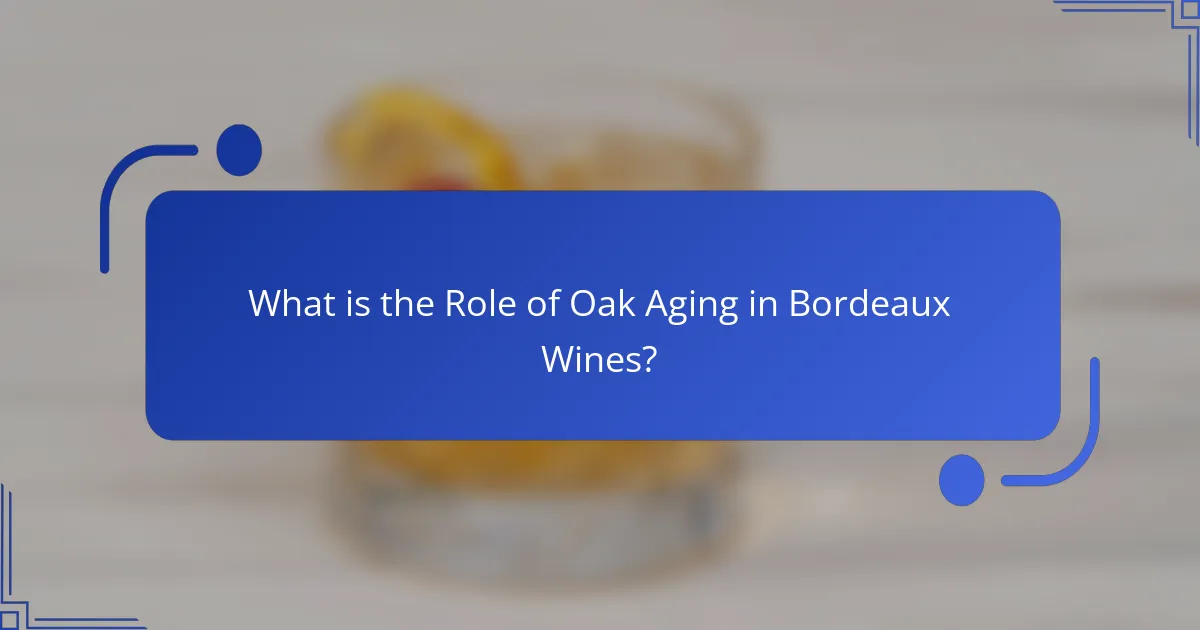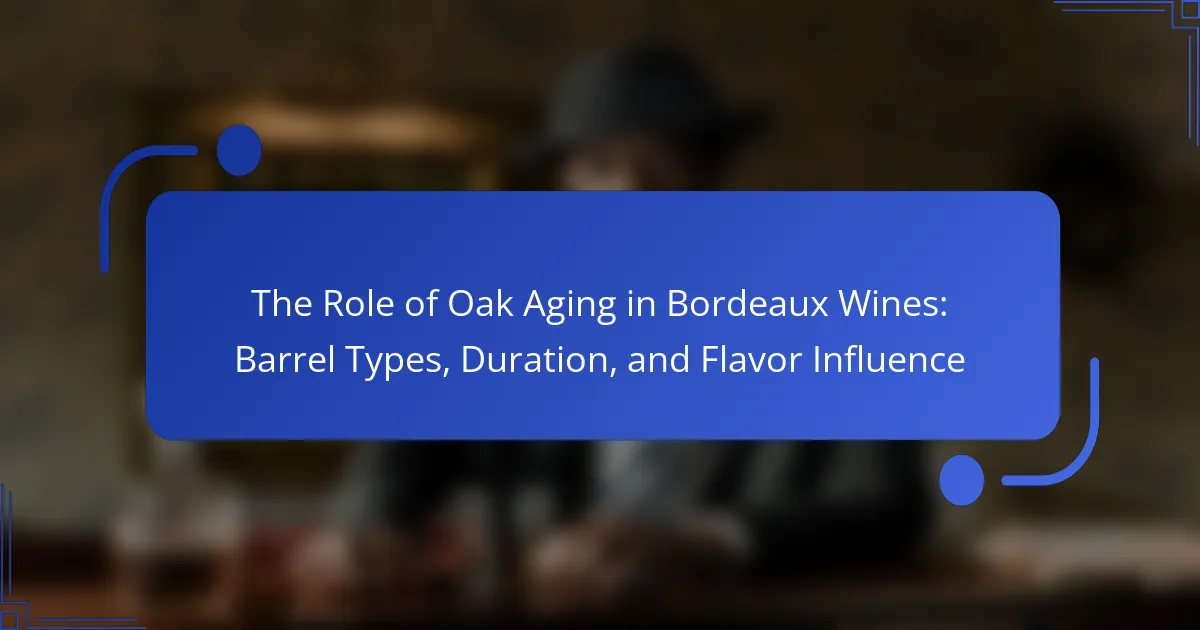
What is the Role of Oak Aging in Bordeaux Wines?
Oak aging plays a crucial role in the development of Bordeaux wines. It enhances flavor complexity and adds depth to the wine. The process allows for the integration of tannins from the oak, which softens the wine’s structure. Additionally, oak aging contributes vanilla, spice, and toasty notes to the wine profile. Bordeaux wines typically age in new or used French oak barrels. The duration of aging can vary, often lasting from 12 to 24 months. This period influences the intensity of oak characteristics in the final product. Studies show that oak aging can also improve the wine’s aging potential. This results in a more balanced and harmonious wine over time.
How does oak aging influence the characteristics of Bordeaux wines?
Oak aging significantly influences the characteristics of Bordeaux wines. It enhances flavor complexity through the infusion of compounds from the wood. These compounds include vanillin, which adds vanilla notes, and tannins, which contribute to the wine’s structure. Oak aging also promotes oxidation, softening the wine’s tannins and improving mouthfeel. The duration of aging affects the intensity of these flavors. Typically, Bordeaux wines age in oak barrels for 12 to 24 months. French oak is commonly used due to its fine grain and aromatic qualities. The choice of barrel and its toasting level further impacts the flavor profile. Studies show that oak aging can increase the perceived quality and aging potential of Bordeaux wines.
What are the primary components of oak aging that affect wine flavor?
The primary components of oak aging that affect wine flavor are tannins, lignin, and vanillin. Tannins contribute to the structure and mouthfeel of the wine. They come from the oak wood and interact with wine compounds. Lignin breaks down during the aging process, releasing aromatic compounds. These compounds enhance the complexity of the wine’s bouquet. Vanillin, derived from the breakdown of lignin, imparts a vanilla aroma and flavor. The degree of toasting of the oak barrel also influences these components. Higher toast levels can enhance the release of these flavor compounds. Research shows that different oak species can further alter the flavor profile of the wine. For instance, French oak typically offers more subtle flavors compared to American oak.
How does the interaction between wine and oak barrels enhance taste?
The interaction between wine and oak barrels enhances taste by allowing the wine to absorb flavors and compounds from the wood. Oak barrels contribute vanilla, spice, and toasted notes to the wine. The porous nature of oak facilitates oxygen exposure, which softens tannins and enhances mouthfeel. This process also promotes the development of complex aromas. Additionally, the interaction encourages the integration of flavors, creating a more harmonious profile. Research indicates that aging in oak can significantly improve wine quality and complexity. Studies show that wines aged in oak barrels exhibit greater depth compared to those aged in stainless steel.
What types of oak barrels are used in Bordeaux wine aging?
Bordeaux wine aging primarily utilizes French oak barrels. These barrels are known for their tight grain and porous nature. The tight grain allows for a slow oxygen exchange. This process enhances the wine’s complexity and flavor profile. Additionally, Bordeaux winemakers may use American oak barrels. American oak imparts more pronounced vanilla and coconut flavors. The choice between French and American oak can influence the wine’s final taste. Most Bordeaux wines age in barrels ranging from 225 to 500 liters. The specific type of oak barrel contributes significantly to the wine’s character and aging potential.
What are the differences between French and American oak barrels?
French oak barrels typically have a tighter grain than American oak barrels. This difference affects the flavor profile imparted to wines. French oak provides more subtle, nuanced flavors such as spice and vanilla. American oak, on the other hand, tends to impart stronger flavors, including coconut and caramel.
The toasting process also varies between the two. French oak is often toasted more gently, enhancing complexity without overpowering the wine. American oak is usually toasted more aggressively, which can lead to bolder flavors.
In terms of cost, French oak barrels are generally more expensive due to their quality and the sourcing process. American oak barrels are more affordable and widely available.
These differences influence the aging process and the overall character of Bordeaux wines. The choice between French and American oak ultimately depends on the desired flavor profile and style of the wine being produced.
How does the toasting level of barrels impact the flavor profile?
The toasting level of barrels significantly impacts the flavor profile of wines. Toasting caramelizes the wood sugars and alters the chemical composition of the oak. Light toasting often imparts subtle vanilla and floral notes. Medium toasting enhances these flavors while adding spice and nutty characteristics. Heavy toasting introduces more intense flavors like chocolate, coffee, and smoke. Research indicates that the toasting process influences the extraction of tannins and phenolic compounds. These compounds contribute to the wine’s complexity and mouthfeel. Therefore, the choice of toasting level is crucial for winemakers aiming to achieve specific flavor profiles in Bordeaux wines.
What is the significance of aging duration in Bordeaux wines?
Aging duration is crucial in Bordeaux wines as it influences flavor complexity and tannin integration. Longer aging allows for the development of secondary and tertiary aromas, such as spice and earthiness. Bordeaux wines typically age in oak barrels, which impart unique characteristics. The interaction between wine and wood enhances flavor profiles and adds depth. Studies show that wines aged for extended periods often exhibit smoother tannins. This smoothness is a result of the gradual polymerization of tannins during aging. Additionally, aging duration can affect the wine’s aroma intensity and overall balance. For instance, wines aged for a minimum of 10 years often reveal more nuanced flavors compared to younger counterparts.
How does aging time correlate with flavor development in Bordeaux wines?
Aging time significantly influences flavor development in Bordeaux wines. As Bordeaux wines age, they undergo chemical changes that enhance their complexity. The interaction with oak barrels contributes to this transformation. Tannins soften over time, leading to a smoother mouthfeel. Aromatic compounds evolve, resulting in notes of vanilla, spice, and toast. Research shows that wines aged for longer periods exhibit deeper flavors and greater integration. For instance, a study published in the Journal of Agricultural and Food Chemistry highlights the correlation between aging duration and flavor intensity in Bordeaux wines. Thus, extended aging time is essential for achieving optimal flavor development in these wines.
What are the effects of short-term versus long-term aging on wine quality?
Short-term aging typically enhances the freshness and fruitiness of wine. It preserves the primary flavors and aromas. This aging period can last from a few months to a year. It allows for some integration of oak flavors without overwhelming the wine.
Long-term aging, on the other hand, can lead to greater complexity and depth. This process often spans several years. It allows for the development of tertiary flavors such as earthiness and nuttiness. The tannins soften significantly during this time, leading to a smoother mouthfeel.
Research indicates that wines aged longer in oak barrels often exhibit more pronounced vanilla and spice notes. A study by the University of California, Davis, found that wines aged for five years or more showed a marked increase in complexity compared to those aged for less than a year.
In summary, short-term aging focuses on preserving freshness, while long-term aging develops complexity and depth.
How does oak aging affect the overall quality of Bordeaux wines?
Oak aging enhances the overall quality of Bordeaux wines by imparting complex flavors and improving texture. This process allows the wine to absorb compounds from the wood, such as tannins and vanillin. These compounds contribute to the wine’s aroma and taste, adding notes of spice, vanilla, and toast.
Additionally, oak aging promotes micro-oxygenation, which softens tannins and enhances mouthfeel. This maturation process can increase the wine’s aging potential, allowing it to develop further complexity over time. Studies have shown that Bordeaux wines aged in oak barrels often score higher in blind tastings compared to those not aged in oak.
For example, a study by the University of Bordeaux found that wines aged in French oak barrels exhibited greater aromatic complexity and structure. This evidence supports the conclusion that oak aging plays a crucial role in defining the quality of Bordeaux wines.
What are the common flavor profiles associated with oak-aged Bordeaux wines?
Oak-aged Bordeaux wines commonly exhibit flavors of dark fruits, such as blackberry and plum. They often also have notes of vanilla and spice, derived from the oak. Other frequent flavor profiles include cedar, tobacco, and chocolate. The aging process in oak barrels adds complexity and depth to the wine. The interaction with the wood influences the wine’s aromatic profile. This is supported by the use of French oak, which is traditionally used in Bordeaux. The toasting level of the barrels can further enhance these flavors. Overall, oak aging significantly shapes the sensory experience of Bordeaux wines.
How do specific aging techniques contribute to unique flavor notes?
Specific aging techniques significantly influence the unique flavor notes in Bordeaux wines. Techniques such as barrel type, toasting level, and aging duration directly impact the wine’s sensory profile. For instance, new French oak barrels impart vanilla, spice, and toasted notes due to their tight grain and high tannin content. The toasting process caramelizes the wood sugars, enhancing flavors like chocolate and coffee. Additionally, aging duration allows for greater extraction of these compounds, leading to more complex flavor development. Research indicates that wines aged for longer periods in oak exhibit increased depth and richness, with flavors evolving over time. The interaction between the wine and the wood also introduces micro-oxygenation, further refining the flavor profile.
What role does the vineyard’s terroir play in flavor development during aging?
The vineyard’s terroir significantly influences flavor development during aging. Terroir encompasses soil composition, climate, and topography. These factors affect grape characteristics, impacting flavor profiles. For example, mineral-rich soils can impart unique notes to the wine. Additionally, climate affects grape ripeness and acidity levels. The interaction between these elements shapes the wine’s complexity over time. Studies show that wines from distinct terroirs exhibit recognizable flavor signatures. This distinctiveness becomes more pronounced during aging, as the wine interacts with oak barrels. The aging process enhances these terroir-driven flavors, making them more integrated and nuanced.
What best practices should be followed for oak aging in Bordeaux wines?
The best practices for oak aging in Bordeaux wines include selecting high-quality oak barrels. French oak is preferred for its flavor contribution. The toast level of the barrel should match the wine’s profile. Longer aging periods, typically 12 to 24 months, enhance complexity. Regular monitoring of the wine’s development is crucial. Racking the wine periodically helps clarify it and integrate flavors. Maintaining optimal storage conditions preserves wine quality. These practices ensure the wine develops desirable characteristics and balance.
The primary entity of this article is oak aging in Bordeaux wines, which significantly influences their flavor, structure, and overall quality. The article explores how oak aging enhances flavor complexity through the infusion of compounds such as tannins, vanillin, and lignin, while also discussing the impact of different barrel types, including French and American oak, on flavor profiles. It details the importance of aging duration, highlighting how longer aging periods contribute to smoother tannins and deeper flavors. Additionally, the article outlines best practices for oak aging, including barrel selection and monitoring, to achieve optimal wine characteristics.
